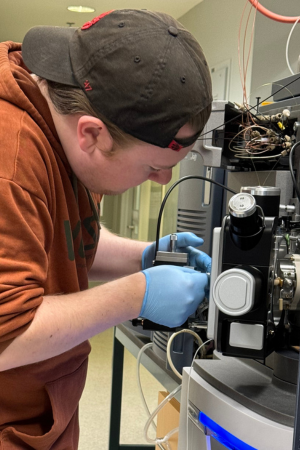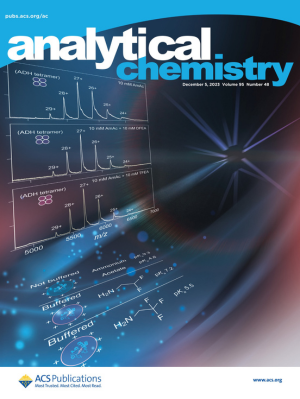Newly discovered buffers improve analysis of biomolecules using mass spectrometry
Molecular and Cellular Biology PhD student Bradley Davis, working in Dr. Siavash Vahidi’s lab with senior research associate Dr. Algirdas Velyvis, has found a solution to a problem experienced by many scientists, especially biologists working with mass spectrometers: he has discovered two buffers compatible with electrospray ionization mass spectrometry (ESI-MS) that allow for biomolecules to be studied at a neutral pH.

Studying biomolecules, such as proteins or DNA, involve isolating them from their natural environment, a cell, for instance. It is important for researchers to maintain the conditions a biomolecule experiences within the cell. pH, a measure of acidity, is one factor that must be carefully controlled to ensure the biomolecule is in a native-like state before any characterization can occur. For this reason, biochemists use buffers to maintain a stable pH, which is crucial to the structure and function of biomolecules. However, only a handful of buffers, such as ammonium acetate, are compatible with native electrospray ionization mass spectrometry, a specialized methodology used to study a biomolecule in its native-like state, and none offer buffering capacity at neutral pH before this discovery.
“Most of the biomolecules biochemists are studying are in the context of how they operate within a cell,” says Davis. “So it’s important to get as close to physiological pH, about 7.0-7.5, as you can. You want to closely mimic what the protein would be experiencing in its actual environment.”
By using modified ethylamines, Davis demonstrated that these compounds not only offer buffer capacity at neutral pH but are also compatible with ESI-MS. Both 2,2-difluoroethylamine (DFEA) and 2,2,2-trifluoroethylamine (TFEA) produce data comparable or better compared to that of ammonium acetate, the most common buffer used for native MS. Additionally, both buffers are highly volatile, the ability to evaporate at a lower temperature, which is necessary for use in a mass spectrometer.
The discovery will impact researchers working in many fields, including biochemistry and bioanalytical chemistry, but will also be beneficial in medicine, pharmaceuticals, food and water testing, environmental labs, and many other industries.
“Even if it’s not biological, anything you put into the mass spectrometer must pass certain criteria and the compounds that are compatible are few and far between,” says Vahidi. “It’s not an exaggeration to say we increased the number of compatible buffers by 20%, even though we’ve only added two.”
 “This is really going to open the door to the analysis of compounds that were previously thought to be incompatible with mass spectrometry.”
“This is really going to open the door to the analysis of compounds that were previously thought to be incompatible with mass spectrometry.”
The finding was recently published in the journal Analytical Chemistry published by the American Chemical Society and was named Editor’s Choice, which means it is among the top 2% of articles accepted into the journal. The article was also featured on the journal’s cover. Even before the article’s publication, the finding generated a lot of excitement. The researchers have been invited to speak about the topic at conference hosted by the Canadian Society for Mass Spectrometry.
Davis, Velyvis, and Vahidi are in contact with instrument manufacturers to license the buffer so members of the scientific community can easily use the compounds in native-MS experiments. They’re also in the process of filing for patent protection.
They hope the discovery will inspire more research into potential ESI-MS-compatible buffers and to improving mass spectrometry methodology.
“There are more avenues out there,” says Davis. “This discovery shows that it’s worth looking into. Maybe these compounds are stepping stones to something even better. If someone can improve on this and progress the work even further, I highly encourage that.”